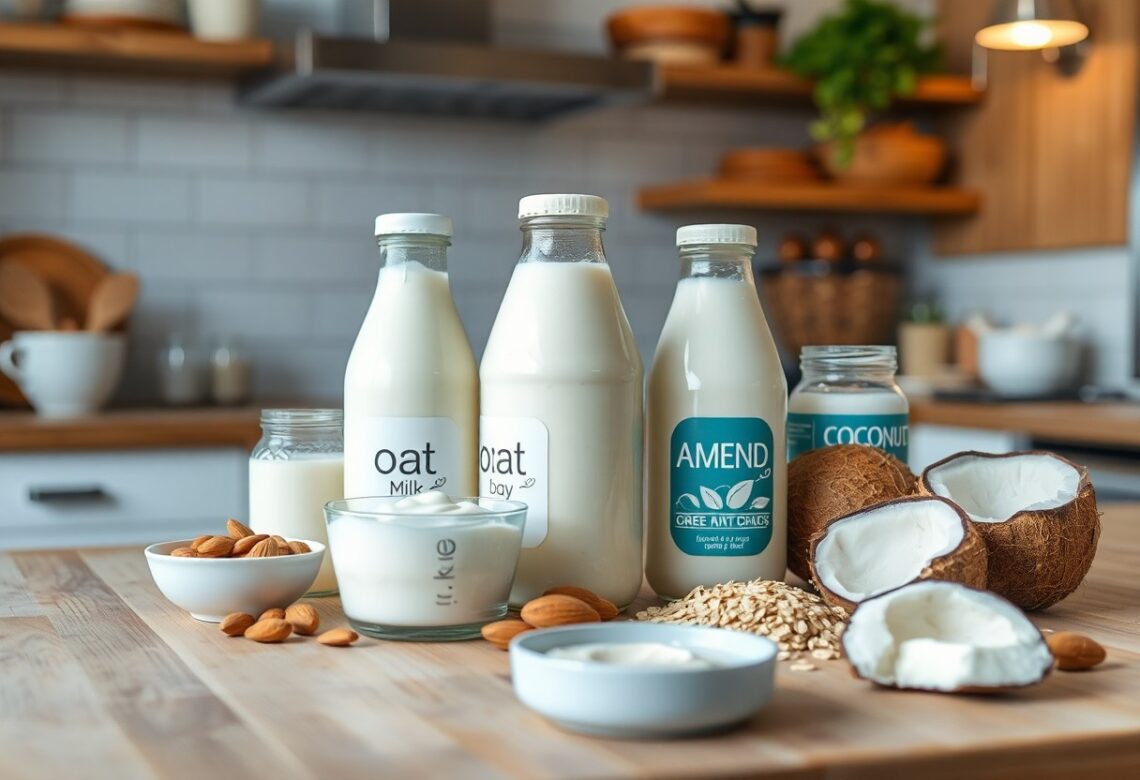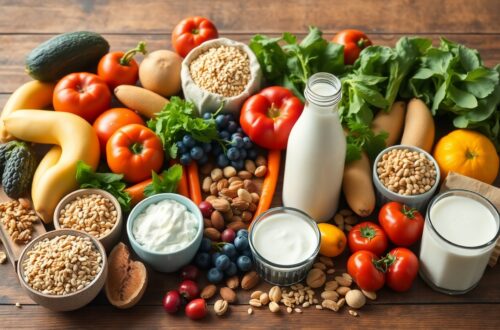Just as traditional dairy products have their place in the kitchen, a wide array of dairy alternatives offers you exciting options for your meals. This complete guide will introduce you to various plant-based milks, cheeses, and yogurts, helping you navigate the myriad of choices available today. Whether you’re lactose intolerant, vegan, or simply seeking to diversify your diet, understanding the benefits and uses of these alternatives is imperative for enhancing your culinary journey. Dive in to discover how to incorporate these versatile substitutes into your daily routine, making healthy eating both delicious and accessible.
Key Takeaways:
- Variety: Dairy alternatives encompass a wide range of options including nut milks, soy milk, oat milk, and coconut milk, catering to different preferences and dietary needs.
- Nutritional Profile: Each alternative varies in its nutritional content, such as protein levels, carbohydrate content, and vitamins, making it imperative to choose one that meets your dietary requirements.
- Flavor: The taste of dairy alternatives differs significantly; for instance, almond milk is often nuttier while oat milk has a creamier texture, influencing their use in recipes.
- Food Compatibility: Certain dairy alternatives work better with specific dishes; for instance, soy milk is considered optimal for baking, while coconut milk enhances tropical flavors.
- Environmental Impact: Dairy alternatives can have a lower carbon footprint compared to conventional dairy, making them a more sustainable choice for environmentally-conscious consumers.
- Allergies and Intolerances: Many options are suitable for individuals with lactose intolerance or dairy allergies, providing safe alternatives without compromising on taste.
- Fortification: Many dairy alternatives are fortified with calcium and vitamins, ensuring they provide comparable nutritional benefits to traditional dairy products.
Types of Dairy Alternatives
A wide range of dairy alternatives is available to suit various dietary preferences and needs. The choices include:
- Plant-based milks
- Non-dairy yogurts
- Dairy-free cheeses
- Cream alternatives
- Plant-based butters
Perceiving the diversity of these options can help you make informed choices that align with your lifestyle.
| Type | Common Ingredients |
| Plant-Based Milks | Almonds, soy, oats, coconuts |
| Non-Dairy Yogurts | Coconut, almond, soy |
| Dairy-Free Cheeses | Cashews, coconut oil, soy |
| Cream Alternatives | Cashews, coconut, soy |
| Plant-Based Butters | Coconut oil, avocado, nuts |
Plant-Based Milks
Dairy alternatives have widened the selection of plant-based milks, offering various flavors and nutritional profiles. You can choose from almond, soy, oat, and coconut milks, each providing unique benefits and taste profiles suitable for different recipes or beverages.
Non-Dairy Yogurts
On your journey to explore dairy alternatives, non-dairy yogurts offer a creamy texture without lactose. Made from ingredients like coconut, almond, or soy, these yogurts provide a delicious and versatile option for breakfast, snacks, or desserts.
The variety of flavors and textures available in non-dairy yogurts makes them easy to integrate into your diet. You can find options that are fortified with vitamins and probiotics, enhancing your overall nutrition while satisfying your palate.
Dairy-Free Cheeses
Plant-based cheeses are continually gaining popularity among those seeking dairy alternatives. Often made from nuts or soy, these cheeses can be found in various styles such as slices, shreds, and spreads, catering to different culinary needs.
This innovative category allows you to enjoy the familiar taste and texture of cheese while adhering to a dairy-free lifestyle. With countless varieties available, you can experiment with flavors to find the ones that complement your favorite dishes.
Cream Alternatives
Even your favorite recipes can be adapted with cream alternatives, providing a rich and indulgent texture without dairy. These products can include cashew cream or coconut cream, which mimic the consistency of heavy cream while adding a unique flavor.
It’s important to explore the different cream alternatives available, as they can enhance sauces, soups, and desserts. By selecting the right cream substitute, you can elevate your dishes while maintaining a dairy-free diet.
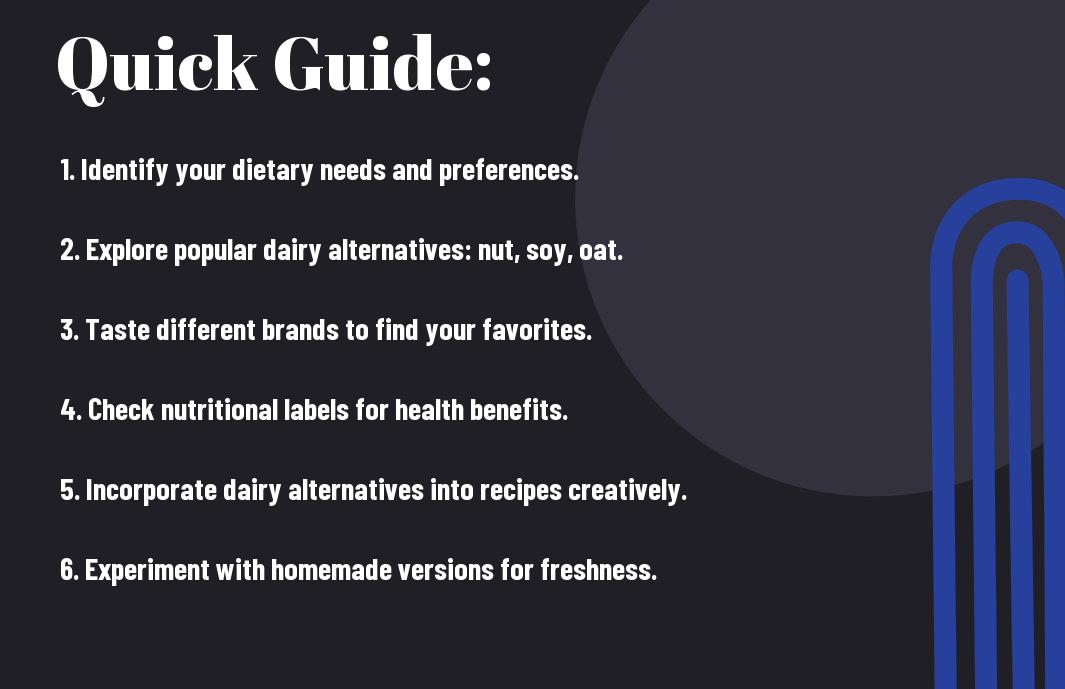
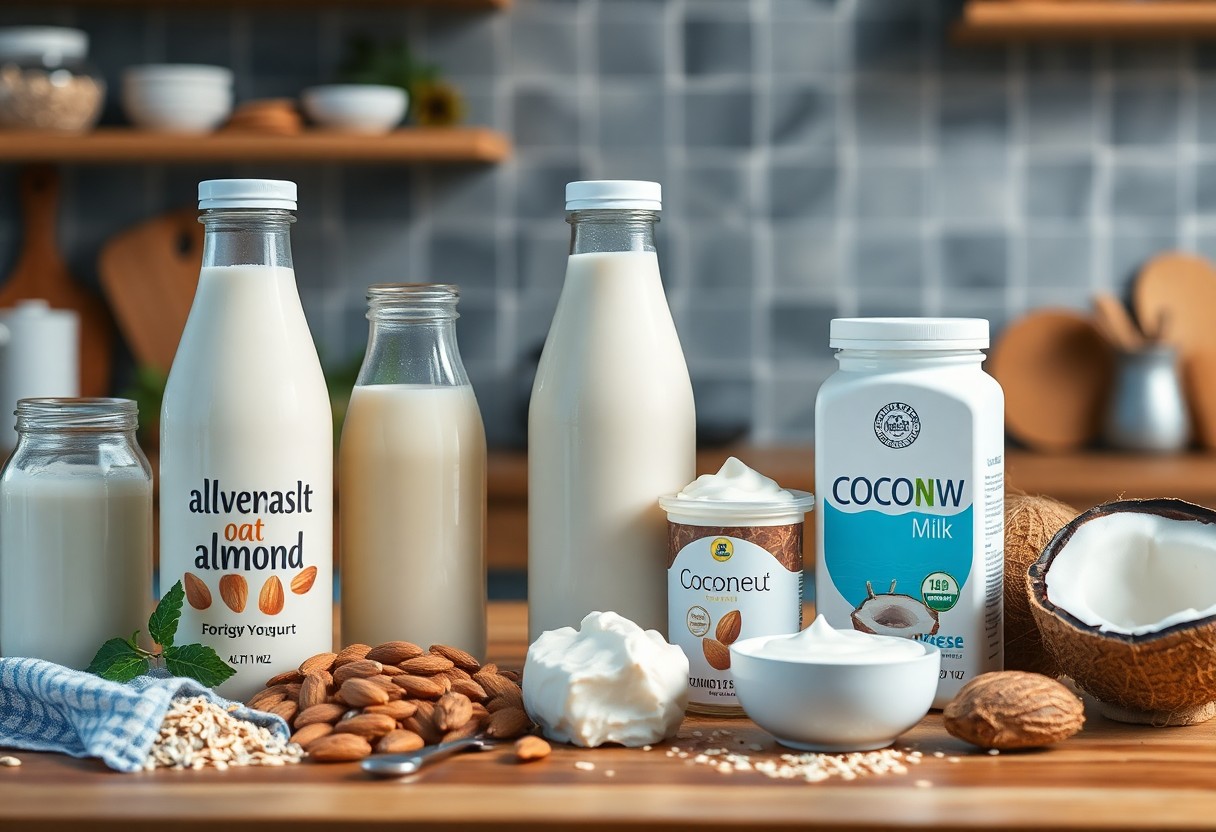
Tips for Choosing Dairy Alternatives
Despite the wide variety of dairy alternatives available, selecting the right one for your needs can be overwhelming. Consider these factors to make informed choices:
- Check for added sugars
- Look for fortified options
- Consider your dietary restrictions
- Sample different types to find your preference
Thou should strive for a balance between taste and nutritional value.
Nutritional Considerations
You must assess the nutritional labeling of dairy alternatives to ensure they meet your dietary needs. Pay attention to protein content, calcium levels, and vitamins added during processing. Some options, like almond milk, are lower in protein compared to cow’s milk, while others, such as soy milk, can provide comparable amounts. Opt for fortified products to support your overall health.
Flavor Profiles
Alternatives to dairy come with a range of flavor profiles that can significantly affect your meals and beverages. Consider whether you prefer a neutral base or something more pronounced, like coconut or almond. Each alternative has its unique taste and texture, which can enhance or alter your favorite recipes, such as using cashew cream for a rich sauce or oat milk in coffee for a creamy texture.
With many options available, exploring flavor profiles allows you to experiment and find the right dairy alternative that suits your palate. Some alternatives like coconut milk deliver a tropical sweetness, while others like soy milk maintain a closer resemblance to traditional dairy. Take the time to try different brands and varieties to discover the flavors that best complement your favorite dishes and drinks.
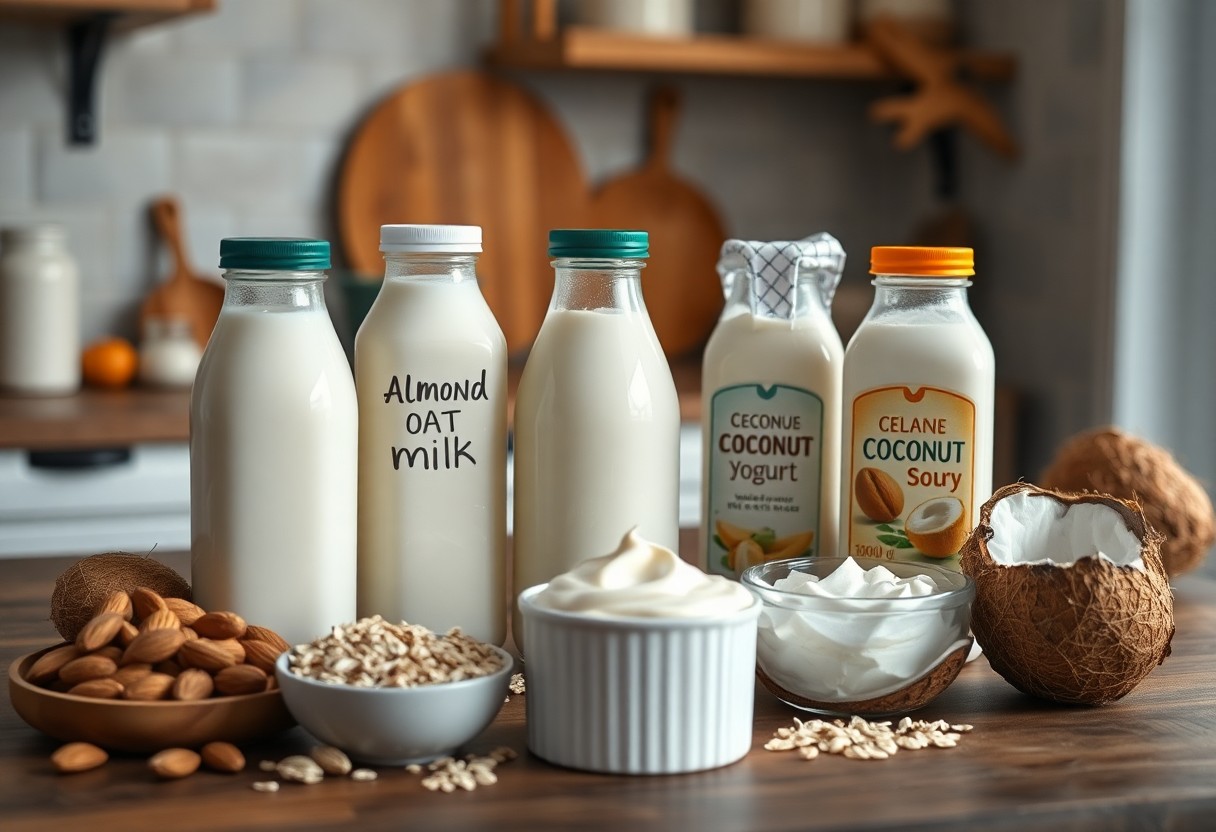
Step-by-Step Guide to Switching to Dairy Alternatives
Once again, transitioning to dairy alternatives can be a manageable process when approached thoughtfully. Start by evaluating your current consumption of dairy products and explore the various options available. Below is a helpful table to guide you through the steps of switching to dairy alternatives.
| Step | Action |
|---|---|
| 1 | Identify dairy products you regularly consume. |
| 2 | Research alternative products that suit your taste and dietary needs. |
| 3 | Plan a schedule for gradually introducing alternatives. |
| 4 | Monitor your body’s response to new products. |
Assessing Your Needs
Even before switching, assess your dietary preferences, health goals, and any allergies. This will help you choose the right dairy alternatives that fit seamlessly into your lifestyle, ensuring a positive transition that supports your individual needs.
Gradual Substitution Methods
Any successful switch can be achieved by gradually substituting dairy products with dairy alternatives. This approach can ease your transition and helps your palate adapt to new flavors without overwhelming your taste buds.
StepbyStep, start by replacing one dairy product at a time. For example, swap regular milk for almond or oat milk in your morning coffee, then transition to vegan cheese or yogurt in subsequent weeks. By making these changes slowly, you’ll allow your body to adjust, while also discovering which alternatives you enjoy the most. This method not only lightens the adjustment period but also minimizes waste as you finish existing dairy products before replacing them. Enjoy the process of experimenting with various alternatives until you find your favorites!
Factors to Consider When Selecting Dairy Alternatives
Many factors influence your choice of dairy alternatives. Consider the following:
- Nutritional content
- Taste and texture
- Allergen compatibility
- Environmental impact
As you explore options, you can refer to the Dairy Alternatives Guide US [Updated 2023] for comprehensive information. Thou should carefully evaluate your needs and preferences to make the best choice.
Dietary Restrictions
While selecting dairy alternatives, it’s important to consider your dietary restrictions. These can include lactose intolerance, nut allergies, or a plant-based diet. Assessing ingredient labels is vital to ensure the product fits your unique dietary needs and enhances your overall wellness.
Environmental Impact
Dairy alternatives can have a significantly lower environmental impact compared to traditional dairy farming. This affects greenhouse gas emissions, water usage, and land impact. Understanding these factors can help you make eco-conscious decisions that align with your values.
Alternatives such as almond, soy, and oat milk generally require less water and emit fewer greenhouse gases than cow’s milk. By choosing these substitutes, you contribute to a reduction in resource depletion and support sustainable practices within the food industry. Your dedication to environmentally-friendly choices can play a part in fostering a healthier planet for future generations.
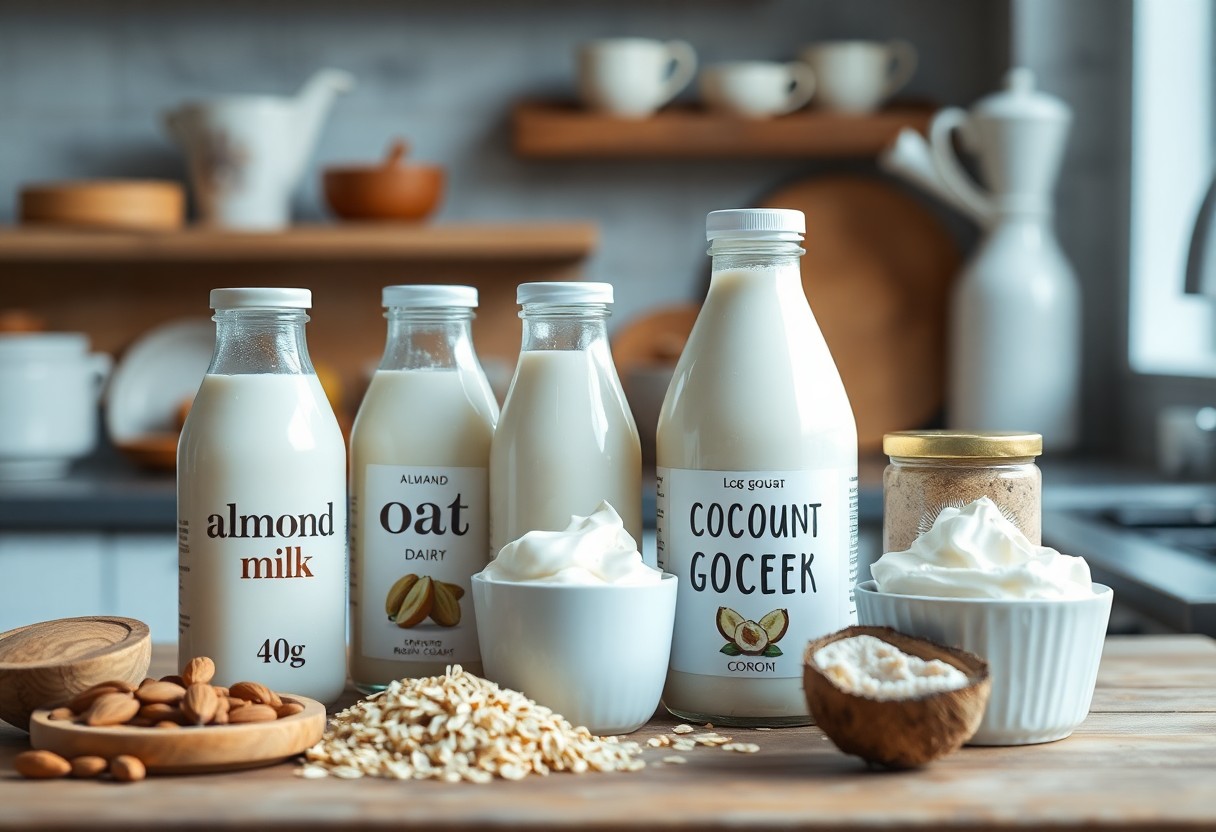
Pros and Cons of Dairy Alternatives
Unlike traditional dairy products, dairy alternatives come with their own set of advantages and disadvantages. Below is a summary to help you weigh your options when considering incorporating these products into your diet. For more details on how to balance Dairy and alternatives in your diet, check the NHS guidelines.
| Lower in calories | May lack protein |
| Lactose-free options available | Some may contain added sugars |
| Variety of flavors and types | Can be more expensive |
| Rich in vitamins and minerals | Sometimes low in calcium |
| Suitable for vegan diets | May cause allergies (e.g., nut milk) |
| Can be easier on digestion | May contain additives and preservatives |
| Environmentally friendly options | Not all are fortified |
Health Benefits
Some dairy alternatives are fortified with necessary nutrients such as calcium and vitamin D, providing similar benefits to those found in cow’s milk. They can help you meet your dietary needs, especially if you’re lactose intolerant or following a vegan lifestyle. Also, many of these alternatives are plant-based, contributing to improved heart health and better digestion.
Potential Drawbacks
You might find that some dairy alternatives do not offer the same protein content as traditional dairy, which could impact your dietary balance. Additionally, certain options may contain added sugars or artificial ingredients that detract from their health benefits.
Pros of dairy alternatives include their ability to cater to various dietary preferences and restrictions, but you should keep in mind that some may sacrifice nutritional value for taste. Opt for unsweetened and fortified versions to ensure you meet your nutritional goals while enjoying these versatile products.
Recipes and Uses for Dairy Alternatives
To fully embrace dairy alternatives, exploring various recipes and uses is important. From creamy smoothies and comforting sauces to rich desserts, these plant-based options can easily replace traditional dairy products. Understanding how to incorporate these ingredients into your daily cooking will not only diversify your meals but also enhance your culinary experience, making dairy-free living both delicious and satisfying.
Cooking and Baking Substitutions
Even simple adjustments can yield fantastic dairy-free results in your cooking and baking. For instance, you can replace milk with almond or oat milk, while coconut yogurt can stand in for sour cream. When a recipe calls for butter, consider using coconut oil or a plant-based margarine. These swaps maintain flavor and texture, allowing your favorite dishes to shine without dairy.
Popular Dairy-Free Recipes
To expand your culinary repertoire, consider exploring a variety of popular dairy-free recipes that cater to your taste preferences. From vegan mac and cheese made with cashews to rich chocolate mousse using aquafaba, there’s an abundance of delicious meals and treats waiting for you to discover. These recipes not only help you maintain a dairy-free lifestyle but also introduce unique flavors and textures to your dining experience.
Understanding the impact of dairy-free cooking can inspire creativity in your kitchen. Whether you’re looking for hearty comfort foods or light, refreshing salads, dairy alternatives provide a versatile foundation for countless dishes. From savory appetizers to decadent desserts, you can find inspiration in plant-based cuisine while enjoying nutritious and tasty meals that cater to your dairy-free needs.
To wrap up
As a reminder, exploring dairy alternatives provides you with a range of options that cater to your dietary preferences and health goals. Whether you’re seeking plant-based milk, cheese, or yogurt, understanding the benefits and nutritional profiles of each type can help you make informed choices. By incorporating these alternatives into your diet, you can enjoy diverse flavors and textures, all while supporting your well-being. Embrace the variety available, and find what suits you best as you navigate the world of dairy alternatives.
FAQ
Q: What are dairy alternatives?
A: Dairy alternatives are plant-based products that serve as substitutes for traditional dairy items such as milk, cheese, yogurt, and butter. Common ingredients used include nuts, soy, oats, rice, and legumes, providing similar textures and flavors to their dairy counterparts while catering to different dietary needs, including lactose intolerance and vegan preferences.
Q: What are the nutritional benefits of dairy alternatives?
A: Dairy alternatives often contain fewer calories and less saturated fat compared to whole dairy products, making them suitable for those looking to manage their weight. Many alternatives are fortified with vitamins and minerals, such as calcium and vitamin D, to ensure they meet the nutritional needs of those who may lack these nutrients from avoiding dairy.
Q: How do I choose the right dairy alternative for my diet?
A: When deciding on a dairy alternative, consider your dietary needs and preferences. For instance, if you are lactose intolerant, lactose-free cow’s milk or almond milk may be preferable. If you follow a vegan diet, options like oat milk or soy milk can be suitable. It’s also important to read labels for added sugars, preservatives, and allergen information.
Q: Are dairy alternatives suitable for children?
A: Many dairy alternatives can be suitable for children, but it’s vital to choose fortified versions to ensure they receive necessary nutrients. For infants and toddlers, consult with a pediatrician before introducing alternatives, as breast milk or formula should generally be the primary source of nutrition in the early stages of life.
Q: Can I use dairy alternatives in cooking and baking?
A: Absolutely! Dairy alternatives can be used in a variety of cooking and baking applications. However, keep in mind that different alternatives have different properties; for example, coconut milk may add richness to soups while almond milk might be used for lighter dishes. Experimenting with these alternatives can yield delicious results.
Q: What are some common allergens in dairy alternatives?
A: Common allergens associated with dairy alternatives include soy (found in soy milk and tofu) and nuts (in almond, cashew, and coconut products). Additionally, gluten can be present in some oat milk products unless specifically labeled gluten-free. Always check packaging for allergen information if you have sensitivities.
Q: How sustainable are dairy alternatives compared to traditional dairy?
A: Dairy alternatives generally have a lower environmental impact than traditional dairy due to reduced greenhouse gas emissions, resource consumption, and water usage during production. For example, almond and oat milk typically require less land and water compared to cows raised for milk production. Nevertheless, it is important to consider sourcing practices when selecting specific brands to ensure sustainability.
